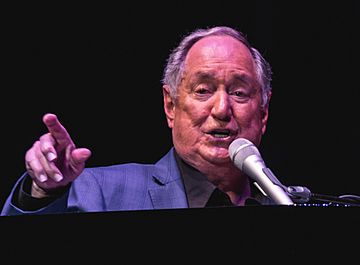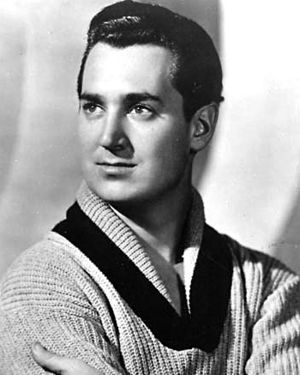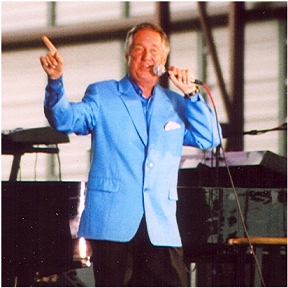Neil Sedaka facts for kids
Quick facts for kids
Neil Sedaka
|
|
|---|---|

Sedaka performing in 2017
|
|
| Background information | |
| Born | March 13, 1939 New York City, U.S. |
| Genres |
|
| Occupation(s) |
|
| Instruments |
|
| Years active | 1957–present |
| Labels |
|
Neil Sedaka (born March 13, 1939) is an American singer, pianist, and songwriter. Since his career started in 1957, he has sold millions of records. He has written or co-written over 500 songs for himself and other famous artists. He often worked with lyricists Howard Greenfield and Phil Cody.
Sedaka first became famous in the late 1950s and early 1960s. His biggest hits from that time include "Oh! Carol" (1959), "Calendar Girl" (1960), "Happy Birthday Sweet Sixteen" (1961), and "Breaking Up Is Hard to Do" (1962). After his popularity faded in the mid-1960s, he made a huge comeback in the 1970s. He had number-one hits with "Laughter in the Rain" and "Bad Blood".
As a songwriter, he wrote hits for other musicians. These include "Stupid Cupid" for Connie Francis and "Love Will Keep Us Together" for Captain & Tennille. Sedaka was added to the Songwriters Hall of Fame in 1983 and still performs today.
Contents
Early Life and Musical Beginnings
Neil Sedaka was born in Brooklyn, New York. His father, Mac Sedaka, was a taxi driver, and his mother was named Eleanor. He grew up in the Brighton Beach neighborhood.
In second grade, his music teacher noticed his talent. She suggested he take piano lessons. His mother worked a part-time job for six months to buy a used piano for him. In 1947, he earned a scholarship to the famous Juilliard School of Music. He attended special classes for children there on Saturdays. His mother hoped he would become a classical pianist.
However, Sedaka also loved pop music. When he was 13, a neighbor introduced him to her 16-year-old son, Howard Greenfield. Greenfield was a talented writer. The two boys started writing songs together and became a famous songwriting team at the Brill Building in New York City.
Career
Rise to Fame in the Late 1950s
After high school, Sedaka formed a band called The Linc-Tones with some classmates. The group later became known as The Tokens. After Sedaka left to start a solo career, The Tokens had their own hit songs.
Sedaka's first few solo songs were not big hits. But they showed he was a great performer, and the record label RCA Victor signed him. His first single for RCA was "The Diary". It was inspired by his friend, singer Connie Francis. The song became a Top 15 hit in 1958.
After a couple of less successful songs, RCA was thinking about dropping him. Sedaka and his manager convinced them to give him one last chance. He studied the biggest hits of the time to understand what made them popular. Then he wrote "Oh! Carol". The song was a huge success, reaching No. 9 in the U.S. and No. 1 in Italy. It was named after his high school friend, Carole King, who later became a famous singer and songwriter herself.
Big Hits of the Early 1960s
From 1960 to 1962, Sedaka had a string of major hits. These songs made him one of the biggest teen idols of his time.
- "Stairway to Heaven" (No. 9, 1960)
- "Calendar Girl" (No. 4, 1961)
- "Little Devil" (No. 11, 1961)
- "Happy Birthday Sweet Sixteen" (No. 6, 1961)
- "Breaking Up Is Hard to Do" (No. 1, 1962)
- "Next Door to an Angel" (No. 5, 1962)
His song "Breaking Up Is Hard to Do" became his signature song. During this time, he appeared on popular TV shows like American Bandstand.
Writing Songs for Other Stars
Even while he was a star, Sedaka and Howard Greenfield wrote songs for other artists. They wrote several hits for Connie Francis, including "Stupid Cupid" and the theme song for her movie Where the Boys Are.
They also wrote songs for other singers like Jimmy Clanton. Sedaka was also a talented pianist and played the piano on Bobby Darin's 1959 hit song, "Dream Lover".
International Fame
Sedaka was very popular in other countries, especially Italy. He recorded many of his hits in Italian, and they were very successful. He also recorded songs in Spanish, German, Yiddish, and Japanese. His songs "One-Way Ticket to the Blues" and "Calendar Girl" both reached No. 1 in Japan.
The Mid-1960s Struggle
After 1962, Sedaka's popularity in the U.S. started to decline. In 1964, The Beatles and other bands from the British Invasion changed the sound of American music. Sedaka later said, "The Beatles—not good!" for his career at the time.
From 1964 to 1966, only a few of his songs made it onto the charts. His record label, RCA, did not renew his contract in 1966. He stopped performing for a while but continued to write songs. He wrote "Workin' On a Groovy Thing" which became a hit for the group The 5th Dimension.
Comeback in the 1970s
In the early 1970s, Sedaka moved his family to England to restart his career. He remained very popular in the UK and Australia. In 1972, he recorded the album Solitaire with the members of the band 10cc. The title song, "Solitaire", became a hit for both Andy Williams and The Carpenters.
This album marked the start of a new songwriting partnership with lyricist Phil Cody. Together, they wrote many of Sedaka's 1970s hits.
The Rocket Man Lifts Him Up
Singer Elton John was a big fan of Sedaka. In 1973, he signed Sedaka to his new record label, Rocket Records. This helped relaunch Sedaka's career in the United States.
His first album on Rocket Records was Sedaka's Back. It was a collection of his best songs from his UK albums. The single "Laughter in the Rain" went to No. 1 on the Billboard Hot 100 chart in 1975. This was his first No. 1 hit in the U.S. since 1962.
More Number-One Hits
In late 1975, Sedaka released the album The Hungry Years. The first single, "Bad Blood", also hit No. 1. Elton John even sang backup vocals on the track.
The album also included a new, slow version of "Breaking Up Is Hard to Do". This version also became a Top 10 hit. Sedaka is one of the only artists to have a Top 10 hit with two different versions of the same song.
Also in 1975, the duo Captain & Tennille recorded "Love Will Keep Us Together", a song written by Sedaka and Greenfield. It became the biggest-selling song of the year.
Later Career and Lasting Impact
Sedaka continued to record and perform. In 1980, he had a hit duet with his daughter, Dara, called "Should've Never Let You Go".
In 1983, he was inducted into the Songwriters Hall of Fame. He also has a star on the Hollywood Walk of Fame.
American Idol and a New Generation
In 2003, Sedaka was a guest judge on the TV show American Idol. Contestant Clay Aiken sang Sedaka's song "Solitaire". The performance was a huge success. Aiken's recording of the song became the best-selling single of 2004. This introduced Sedaka's music to a whole new generation of fans.
Still Performing
Sedaka continues to tour and record music. In 2020, during the COVID-19 pandemic, he started posting free mini-concerts online from his home to entertain his fans. He continues to create online videos, sometimes with his grandson Mike Sedaka.
In 2024, Sedaka made a deal with the company Primary Wave to help more people discover his classic songs on streaming services. After a break, he returned to live performances in 2025.
Personal Life
Sedaka graduated from Abraham Lincoln High School in 1956. He married Leba Strassberg in 1962. They have two children, a daughter named Dara and a son named Marc.
Dara is also a singer and sang with her father on their 1980 hit song. Marc is a screenwriter. Sedaka is also a grandfather, and his grandson Mike is a musician.
Discography
Images for kids
See also
 In Spanish: Neil Sedaka para niños
In Spanish: Neil Sedaka para niños






